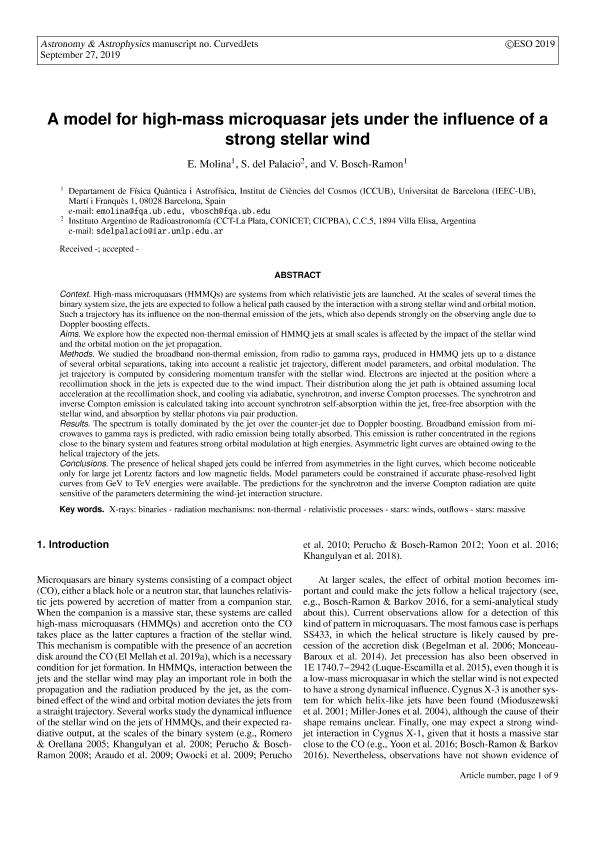Mostrar el registro sencillo del ítem
dc.contributor.author
Molina, E.
dc.contributor.author
del Palacio, Santiago

dc.contributor.author
Bosch Ramon, Valentí

dc.date.available
2020-05-21T17:46:41Z
dc.date.issued
2019-09
dc.identifier.citation
Molina, E.; del Palacio, Santiago; Bosch Ramon, Valentí; A model for high-mass microquasar jets under the influence of a strong stellar wind; EDP Sciences; Astronomy and Astrophysics; 629; A129; 9-2019; 1-10
dc.identifier.issn
0004-6361
dc.identifier.uri
http://hdl.handle.net/11336/105703
dc.description.abstract
Context. High-mass microquasars (HMMQs) are systems from which relativistic jets are launched. At the scales of several times the binary system size, the jets are expected to follow a helical path caused by the interaction with a strong stellar wind and orbital motion. Such a trajectory has its influence on the non-thermal emission of the jets, which also depends strongly on the observing angle due to Doppler boosting effects. <br /> Aims: We explore how the expected non-thermal emission of HMMQ jets at small scales is affected by the impact of the stellar wind and the orbital motion on the jet propagation. <br /> Methods: We studied the broadband non-thermal emission, from radio to gamma rays, produced in HMMQ jets up to a distance of several orbital separations, taking into account a realistic jet trajectory, different model parameters, and orbital modulation. The jet trajectory is computed by considering momentum transfer with the stellar wind. Electrons are injected at the position where a recollimation shock in the jets is expected due to the wind impact. Their distribution along the jet path is obtained assuming local acceleration at the recollimation shock, and cooling via adiabatic, synchrotron, and inverse Compton processes. The synchrotron and inverse Compton emission is calculated taking into account synchrotron self-absorption within the jet, free-free absorption with the stellar wind, and absorption by stellar photons via pair production. <br /> Results: The spectrum is totally dominated by the jet over the counter-jet due to Doppler boosting. Broadband emission from microwaves to gamma rays is predicted, with radio emission being totally absorbed. This emission is rather concentrated in the regions close to the binary system and features strong orbital modulation at high energies. Asymmetric light curves are obtained owing to the helical trajectory of the jets.
dc.format
application/pdf
dc.language.iso
eng
dc.publisher
EDP Sciences

dc.rights
info:eu-repo/semantics/openAccess
dc.rights.uri
https://creativecommons.org/licenses/by-nc-sa/2.5/ar/
dc.subject
Microquasars
dc.subject.classification
Astronomía

dc.subject.classification
Ciencias Físicas

dc.subject.classification
CIENCIAS NATURALES Y EXACTAS

dc.title
A model for high-mass microquasar jets under the influence of a strong stellar wind
dc.type
info:eu-repo/semantics/article
dc.type
info:ar-repo/semantics/artículo
dc.type
info:eu-repo/semantics/publishedVersion
dc.date.updated
2020-05-19T19:00:20Z
dc.journal.volume
629
dc.journal.number
A129
dc.journal.pagination
1-10
dc.journal.pais
Francia

dc.description.fil
Fil: Molina, E.. Universidad de Barcelona; España
dc.description.fil
Fil: del Palacio, Santiago. Provincia de Buenos Aires. Gobernación. Comisión de Investigaciones Científicas. Instituto Argentino de Radioastronomía. Consejo Nacional de Investigaciones Científicas y Técnicas. Centro Científico Tecnológico Conicet - La Plata. Instituto Argentino de Radioastronomía; Argentina
dc.description.fil
Fil: Bosch Ramon, Valentí. Universidad de Barcelona; España
dc.journal.title
Astronomy and Astrophysics

dc.relation.alternativeid
info:eu-repo/semantics/altIdentifier/url/https://www.aanda.org/10.1051/0004-6361/201935960
dc.relation.alternativeid
info:eu-repo/semantics/altIdentifier/doi/http://dx.doi.org/10.1051/0004-6361/201935960
Archivos asociados
